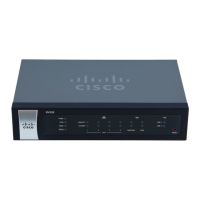
Do you have a question about the Cisco RV320 and is the answer not in the manual?
| Ethernet LAN | Yes |
|---|---|
| Cabling technology | 10/100/1000Base-T(X) |
| Networking standards | IEEE 802.3, IEEE 802.3u |
| Ethernet LAN data rates | 10, 100, 1000 Mbit/s |
| Ethernet interface type | Gigabit Ethernet |
| USB version | 2.0 |
| USB ports quantity | 2 |
| Ethernet LAN (RJ-45) ports | 6 |
| Gigabit Ethernet (copper) ports quantity | 4 |
| Routing protocols | RIP-1, RIP-2 |
| Supported network protocols | IPv4, IPv6, Static IP, PPPoE, PPTP, DNS, DynDNS |
| VPN support | IPsec, L2TP, DPD, DNS |
| Firewall security | Port Address Translation (PAT) firewall, Stateful packet inspection (SPI) firewall, Network address translation (NAT) firewall |
| Security algorithms | 128-bit AES, 192-bit AES, 256-bit AES, 3DES, DES, HTTPS, MD5, SHA-1, SSL/TLS |
| VPN tunnels quantity | 25 |
| Authentication method | SHA-1, MD5 |
| MAC address filtering | - |
| Certification | FCC, CE, UL, cUL, CB, CCC, BSMI, KC, Anatel |
| Storage temperature (T-T) | 0 - 70 °C |
| Operating temperature (T-T) | 0 - 40 °C |
| Storage relative humidity (H-H) | 5 - 90 % |
| Operating relative humidity (H-H) | 10 - 85 % |
| Product color | Black |
| Rack mounting | No |
| LED indicators | Activity, LAN, Link, Power, USB, WAN |
| Input current | 1.5 A |
| Output voltage | 12 V |
| Depth | 44 mm |
|---|---|
| Width | 206 mm |
| Height | 132 mm |
| Weight | - g |
Details the key components and navigation elements of the device's web interface.
Procedure to exit the web interface and return to the login screen.
Displays essential device details like serial number, firmware version, and IP addresses.
Provides an overview of the status of various security features implemented on the device.
Shows the current status of configured VPN tunnels, including those used and available.
Displays the status of SSL VPN tunnels, indicating tunnels in use and available.
Guides users through configuring network settings, including LAN, WAN, and DMZ.
Configures the parameters for the WAN interfaces, including connection types and IP addressing.
Manages connections for USB dongles, including configuration for 3G/4G internet access.
Configures automatic switching between WAN connections (Ethernet and USB) for redundancy.
Configures a Demilitarized Zone (DMZ) subnetwork to expose specific services to the internet.
Covers changing the device's administrative username and password for security.
Enables dynamic routing and adding static routes to manage network traffic flow.
Configures the Dynamic Host Configuration Protocol for IPv4 and IPv6 address assignment.
Allows binding static IP addresses to specific MAC addresses for network devices.
Enables the device to act as a local DNS server for faster domain name resolution.
Manages multiple WAN interfaces for load balancing and link backup for continuous connectivity.
Adjusts bandwidth settings for upstream and downstream traffic and configures QoS.
Configures Simple Network Management Protocol settings for network monitoring.
Describes the process for updating the device's firmware from a PC or USB drive.
Covers procedures for backing up, restoring, and sanitizing device configuration files.
Details how to configure port settings like mirroring, priority, speed, and duplex mode.
Displays a summary of the status of each network port on the device.
Configures Virtual LANs (VLANs) to manage traffic between devices on the network.
Manages general firewall features like SPI, DoS protection, and remote management.
Defines rules to limit network access by specifying services, devices, and IP addresses.
Allows blocking specific domains and website keywords to control web content access.
Displays general information about VPN tunnel settings, including tunnel status.
Configures site-to-site VPN tunnels for secure inter-office network connectivity.
Details the encryption, authentication, and key exchange methods for secure VPN tunnels.
Enables remote users or teleworkers to establish secure VPN tunnels to the network.
Allows VPN clients to pass through the router to connect to a VPN endpoint.
Manages digital certificates, including generating, importing, and exporting them.
Describes Secure Sockets Layer (SSL) certificates for secure web server and browser links.
Provides tools to generate private key files and certificate requests for SSL certificates.
Configures system log settings, including SMS alerts and syslog server integration.
Sets up email notifications for system events and log alerts.
Provides the status of SSL VPN tunnels and logged-in users.
Controls user groups and their access to specific network resources via SSL VPN.
Configures available applications and services for users connecting via SSL VPN.
Guides users through the initial device configuration and internet connection setup.
Assists in creating firewall access rules to define network security policies.
Authenticates users against a local database for access to VPN services.
Configures authentication against a RADIUS server for VPN and portal access.
Sets up authentication using Windows Active Directory for user access.
Integrates with Lightweight Directory Access Protocol servers for user authentication.
Provides contact information and links for technical support and community resources.
Offers links to product documentation and guides for Cisco routers.